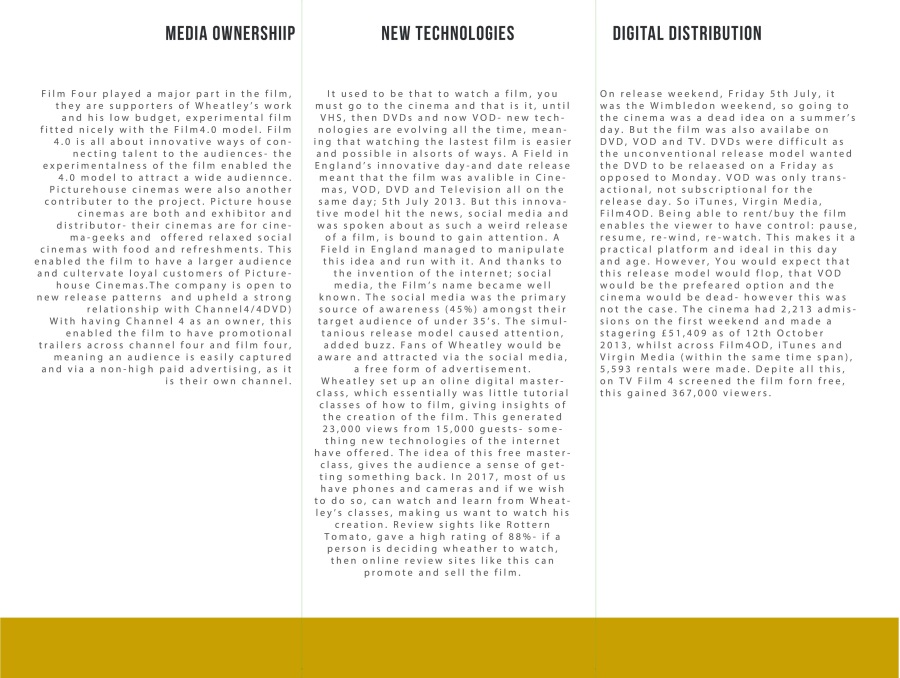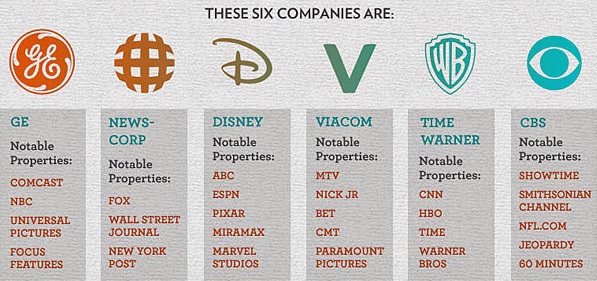To what extent does digital distribution affect marketing and consumption of media products that you have studied?
P L A N
Introduction
Digital distribution (also called content delivery, online distribution, or electronic software distribution (ESD), among others) is the delivery or distribution of media content such as audio, video, software and video games. The term is generally used to describe distribution over an online delivery medium, such as the Internet, thus bypassing physical distribution methods, such as paper, compact discs, and VHS videocassettes. The term online distribution is typically applied to freestanding products; downloadable add-ons for other products are more commonly known as downloadable content. With the advancement of network bandwidth capabilities, online distribution became prominent in the 21st century.
Content distributed online may be streamed or downloaded, and often consists of books, films and television programs, music, software, and video games. Streaming involves downloading and using content at a user’s request, or “on-demand”, rather than allowing a user to store it permanently. By contrast, fully downloading content to a hard drive or other form of storage media may allow offline access in the future.
Timeline
Until the 1930’s the distribution of film was via the cinema
Initially in the 20’s the BBC provided a radio service
Which by the 30’s evolved into broadcasting a TV channel that contained news and light entertainment. This was expensive so not a threat to the cinemas.
By the 40s/50s most people owned a TV as they became more affordable
Sizes changed
Home TV Widescreen
VHS Recording
DVD
Renting- Netflix/Lovefilm BluRay
Piracy
Subscriptions VOD
3D Televisions
4K Televisions
Moved away from physical distribution, but now in fact non-physical (i.e. downloads, stream)
Marketing
Social Media
Posters, logos- ie Netflix originals
Netflix payed $12 million for the global distribution rights of Special Correspondents. The poster advertised it as a Netflix Original that will be made available 29th April “only on Netflix” Netflix can advertise within their own service and via Gervais’ social media. This method enables new VOD subscriptions.
Consumption
Nypmromaniac (2012)
Modern advances within technology enables us to watch films and television anywhere- whilst in bed, on the toilet, on the train: anywhere. And with this advance of technology, we virtually have an entire catalogue of films at our finger tips.
Curzon film released the film on multiple on-demand platforms on their day-and-date release. The film was released on CHC, Sky Store, FilmFlex, BlinkBox and BFI Player and in April the two films were available to buy together as a pack.
The VOD net revenue was £71k and total multi platform, £158,500. Curzon wanted premium prices- therefore on the day-and-date release, it was not released on iTunes as it did not conform to iTunes single prices for rent and ownership.
iTunes
Apple is a widely used platform and comes in the form of Phones, Tv’s , Computers, Laptops, iPhones and iPod Touch. All of these platforms allow the use of iTunes and the consumption of films.
iTunes have a method of strict pricing of £3.49 for SD rentals and £7.99 for SD Purchases. HD Rentals are £7.99 and HD Purchases are £9.99- which allows the consumer to be happy with the quality.
E S S A Y D R A F T I
Across time, the distribution of films has evolved and under-gone technological advancement into what is now digital distribution via the internet. Initially to watch a film, the viewer would have to physically go to the cinema. But then by around the 40s/50s VHS enabled people to have home viewings of films. This then turns into CD’s of Film, then DVD’s (f.t rentals from LoveFilm & Netflix), to Blu-rays and now to what we know as Video on Demand, which can be accessed anywhere via the internet.
The bigger companies are at an advantage as due to their popularity and money advantage, they can carry on with the classic release model of 14 weeks in the cinemas, soon followed by releases on VOD and DVD, a lot like Warner’s 2016 Suicide Squad, which was later released on transactional VOD and physical copies- i.e. BluRay, DVD, 3D and 4K discs. And due to their vast spendeture and reputation, the Big Six can throw a lot of money at the marketing of films.
Smaller film releases however do not have the high reputation that the Big Six do, therefore their releases are an innovative mix that take advantage of the digital distribution model. Ben Wheatley’s 2013, A Field in England and Von Triers’ 2012 Nymphomaniac both had a Day-and-Date release model which received help funding by the BFI.
A week before the day and date release of Nymphomaniac, there was a one-off ‘One Night Stand’, where by the two parts of the film were shown across all UK Curzon Theatres, and Curzon Chelsea held a Q&A which was streamed to all cinemas- this acquired £308,803 theatrical revenue. A week later, the film was released on multiple on demand platforms, with a revenue of £71k, however this did not include iTunes as the film wanted premium pricing which breaches iTunes rentals which start at £3.49.
5th July 2013, Wheatley’s A Field in England was released in PictureHouse Cinemas, streamed on Film4, released on DVD and BluRay and on VOD services. This massively took advantage of all distribution types and made in into mainstream news due to the innovation and singularity of the release. The film made just under £51,500 from the cinemas, sold 7,700 DVDs & BluRays, 5,500 On demand downloads and 376,00 TV ratings. The ratings are not accurate due to the kettle method of gathering data, however most viewers probably tuned in due to the news reports surrounding the innovative release.
The figures for A Field in England were for the first 2 months of the film’s release, however these numbers no way match the big tentpole releases’. Suicide Squad release generated £325,000,00 from DVD and BluRay. Due to the film’s backing from the Big Six company of warner, the film could be released on iTunes without the premium pricing however due to the film owners, numbers for VOD are not available.
As the internet and devices grew more powerful, with a faster internet service, Netflix and LoveFilm evolved into a company that no longer delivered rental DVD’s, but now offer a Subscription VOD service that generated a revenue of £6,850,803,093 in 2016. And as Netflix has gotten bigger, they have started to feature their own ‘Netflix Originals’- for example: Better Call Soul, Black Mirror and Special Correspondents.
Netflix paid 12 million dollars (£9.5 million) for the global distribution rights for Ricky Gervais’ Special Correspondents. All though marketing, it was made clear that the film will only be available via Netflix on the 29th April. This meant that on posters, social media, and generally trailers for the company- it was made apparent that Netflix is the only place this film is shown (along with other Netflix originals), and this generated for subscriptions to the service.
However, this then means that this method of digital distribution means that physical film copies are no longer necessary. Now through Netflix and transaction VOD stores like iTunes and Google Play, there is a whole catalogue of films, at a person’s fingertips, that can be watched instantly, anywhere and anytime- all because of the internet.
As technologies advance, I feel like in the future, film releases will all be digitally distributed. Sky already offer some films that are in the cinemas on their own service and the 30% of the UK who regularly use Piracy sites to obtain their films, can easily watch films that are currently in the cinemas.





